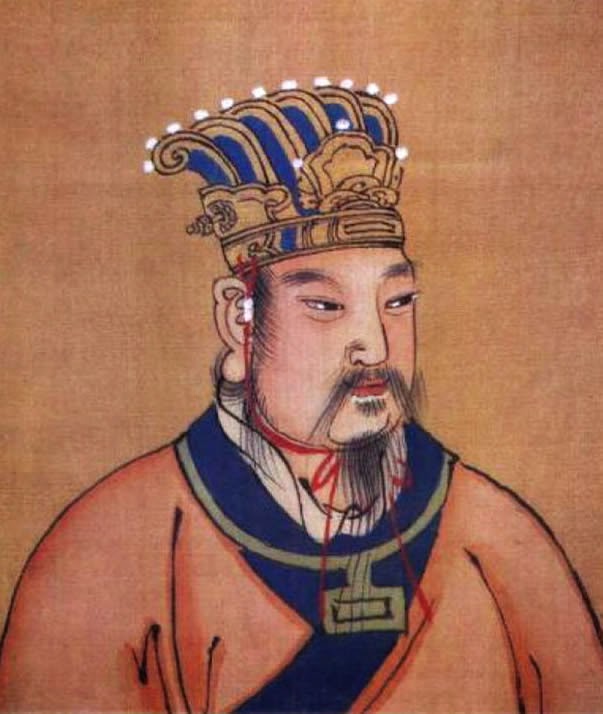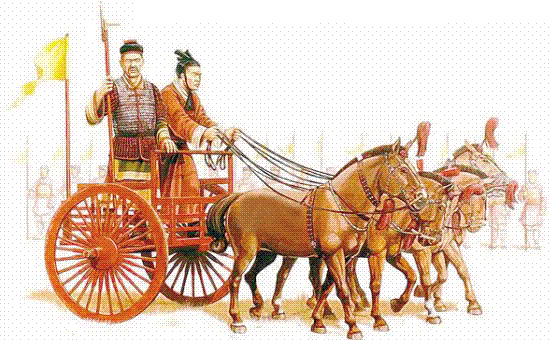 |
| Western Zhou map |
The Zhou, together with the preceding Xia (Hsia) dynasty and Shang dynasty, are called the Three Dynasties in Chinese history. They account for two millennia that are the formative era of the Chinese civilization.
All three dynasties are the products of the Neolithic civilization of northern China, each occupying a different but overlapping region of the Yellow River valley. They are moreover contemporaries of one another, each achieving dominance over several centuries, then receding to subordinate status.
For example, postdynastic Xia became a state called Qi (Ch’i), while postdynastic Shang survived as a state called Song (Sung). Because the Zhou (Chou) was very long lived, it is subdivided into several shorter eras, beginning with the Western Zhou (1122–771 b.c.e.), followed by the Eastern Zhou (770–256 b.c.e.). Eastern Zhou is further subdivided into the Spring and Autumn era (722–481 b.c.e.), followed by the Warring States era (463–222 b.c.e.).
  |
Unlike the Xia and the Shang, multitudes of contemporary written records survived from the Zhou. Early Zhou records include the Shu Jing (Shu Ching), or Book of History (or Book of Documents), which include proclamations, edicts, and pronouncements on the early phase of the dynasty, and the Shi Jing (Shih Ching), or Book of Poetry, with many poems that dealt with the early Zhou era.
These are supplemented by thousands of bronze vessels found in archaeological digs cast with inscriptions up to 500 words long that described important events, such as battles and the creation of fiefs. The number of surviving written works multiplied with the progress of time. The information they provide are supplemented by other material evidence from thousands of excavated Zhou sites.
 |
| King Wen of Zhou |
King Wen and Wu
Predynastic Zhou people were frontiersmen living in the Plain of Zhou where the Wei River joined the Yellow River in modern Sha’anxi (Shensi) Province. They acted as a bastion against the "barbarians" beyond the frontiers, and their leader was given the title Lord of the West by Shang kings.
King Wen (the Cultivated) was the first great Zhou leader, noted for his benevolence and for building up his state that could challenge the Shang. Wen’s son, King Wu (the Martial), followed him in 1133 b.c.e. Wu formed a coalition with eight other states disgruntled with the Shang.
In 1122 b.c.e. Wu’s forces decisively defeated the Shang king Shou at the Battle of Muye (Mu-yeh), who then committed suicide. Wu died shortly after destroying the Shang and left the task of consolidating the new dynasty to his brother, the Duke of Zhou (Chou), who acted as regent for Wu’s young son for seven years.
 |
| Battle of Muye |
The Duke of Zhou
The Duke of Zhou fought to defeat remnant Shang forces and enlarged the realm to the eastern seaboard, creating a state that is larger than modern-day France. He governed the realm from two capitals, the original Zhou capital at Hao, near modern Xi’an (Sian), and a new one called Luoyang (Loyang), further down the Yellow River valley to govern the former Shang lands and beyond.
 |
| The Duke of Zhou |
Most people were farmers with status similar to that of European medieval serfs who changed hands with the land. Ideally eight families farmed individual plots around a manor and jointly farmed the ninth plot for the lord. The farming system was called the well-field system.
These political and economic arrangements resembled those of European feudalism during the Middle Ages; hence the Zhou system is also called feudal. In retrospect, King Wen the dynastic founder, King Wu the conqueror, and the Duke of Zhou the consolidator are honored as sage rulers, who established a golden age.
Western Zhou
For three centuries Zhou kings generally maintained internal peace and expanded the frontiers until 771 b.c.e. when non-Chinese tribal people overran the capital, Hao, and killed King Yu. Reputedly he had numerous times falsely summoned the feudal lords to march their troops to the capital because the sight of massed troops pleased his favorite lady. Then when a true emergency occurred, the disgruntled lords had refused to come. The survivors of the Zhou court abandoned Hao in favor of the second capital, Luoyang.
 |
| Zhou dynasty chariot |
Eastern Zhou
The Eastern Zhou (770–256 b.c.e.) saw progressive decline of the power of the kings, whose domain was reduced to land around Luoyang. The king was consulted perfunctorily, then only on genealogical matters. Powerful regional states emerged, warring among themselves, gradually swallowing up the lesser ones. The Zhou monarchs remained on the throne until 256 b.c.e. because they were too insignificant to count.
The 500 years of the Eastern Zhou is divided into the Spring and Autumn era after a book of the same name by Confucius that chronicled the history of his state, Lu (ruled by descendants of the Duke of Zhou), from 722 to 481 b.c.e. In 681 b.c.e., in response to threats from Zhu (Ch’u), a new state in the south, the remaining states joined to form an alliance, and because the Zhou king was powerless to keep the peace, they elected one lord hegemon, or ba (pa) in Chinese.
For the next 200 years the reigning dukes of several of the states were successively elected hegemon, convening conferences between the states at intervals and formulating policies or waging wars, or keeping a precarious peace.
This was a stopgap solution to maintain some order in the Chinese world without the power and leadership of Zhou kings, who were consulted proforma and ratified decisions that were already made. The chief feature of the Spring and Autumn era was interstate diplomatic sparring and generally small-scale wars fought by chariot-driving knights.
Many of the rival leaders were related by blood, and the defeated lord was shamed rather than killed. A large battle fought between Jin (Chin) and Qi (Ch’i) in 589 b.c.e. involved 800 chariots and 12,000 men, but most battles were smaller. By the end of the era 110 states had been reduced to 22.
Warring State
The Warring States era (463–222 b.c.e.) that followed was also named after a book, The Annals of the Warring States. The wars became very destructive and were fought by large disciplined infantry armies, fewer chariots (which were not useful in varied terrain), and more cavalry. Iron weapons replaced bronze ones, and the powerful crossbow came into general use.
Whereas the Chinese world up to 335 b.c.e. had only one king, thereafter the rulers of major states also began to call themselves kings; in 256 b.c.e. one state, Qin (Ch’in) deposed the last Zhou king and annexed his domain. The continued fighting between the seven major states that had emerged was based on the accepted premise that all China be unified under one ruler. The final victor was Qin in northwestern China.
Fighting the non-Chinese nomads toughened its people, its frontier position saved it from earlier phases of destructive wars between the other states, and its conquest of the Sichuan (Szechwan) plains gave it huge new resources. Finally its state ideology, called Legalism, enabled Qin to build a strong economy, large army, and efficient bureaucracy that allowed it to launch a final successful drive for unification, achieved in 221 b.c.e.
Technological and Philosophical Advancements
Many social and economic changes occurred during the Eastern Zhou period. Early farming by serfs was gradually replaced by freehold farming. Qin led the way by ending feudalism on the premise that free tax-paying farmers would work and fight harder.
By the fifth century b.c.e. iron tools had replaced stone and wooden ones in land clearing and farming, increasing acreage using iron-tipped, animal-drawn plows that replaced wooden digging sticks. Borrowing techniques used in bronze making, Chinese metal smiths were making cast-iron tools and weapons 1,000 years earlier than their counterparts in Europe.
States competing for supremacy encouraged advanced farming techniques that included irrigation, fertilization, and crop rotation. Hunting and grazing decreased in importance as more land was used for crops. Manufacturing and commerce flourished; sizable multifunctional towns proliferated, and growing artisan and merchant classes emerged.
During the Warring States period the capital city of Qi boasted a population of 70,000 households. Cowrie shells, bolts of silk, and dogs were used as media of exchange in an earlier primarily barter economy, and cast-metal coins became common by the mid-fifth century.
The Zhou conquest appeared to have ushered in a period of social mobility—the establishment of a new Zhou order resulted in stability when positions and jobs became hereditary. By the Warring States era society had outgrown the old order; merchants did not fit into the feudal hierarchy.
More important, the competitive political scene encouraged rulers to hire and promote men based on merit and not birth. Capable men began to sell their talents wherever they could find employment. The frequent wars also made for social mobility. Men and women from the losing side lost at least their status; in many instances lords and ladies from defeated states became slaves and servants to their conquerors.
The lowest among the aristocrats, the shi (shih), originally professional fighting men, became educated and served as bureaucrats of the rulers. Some among them became teachers and philosophers. They became the teachers of the Hundred Schools of Philosophy, and their ideas, writings, and debates produced the classical philosophies of the Chinese civilization.